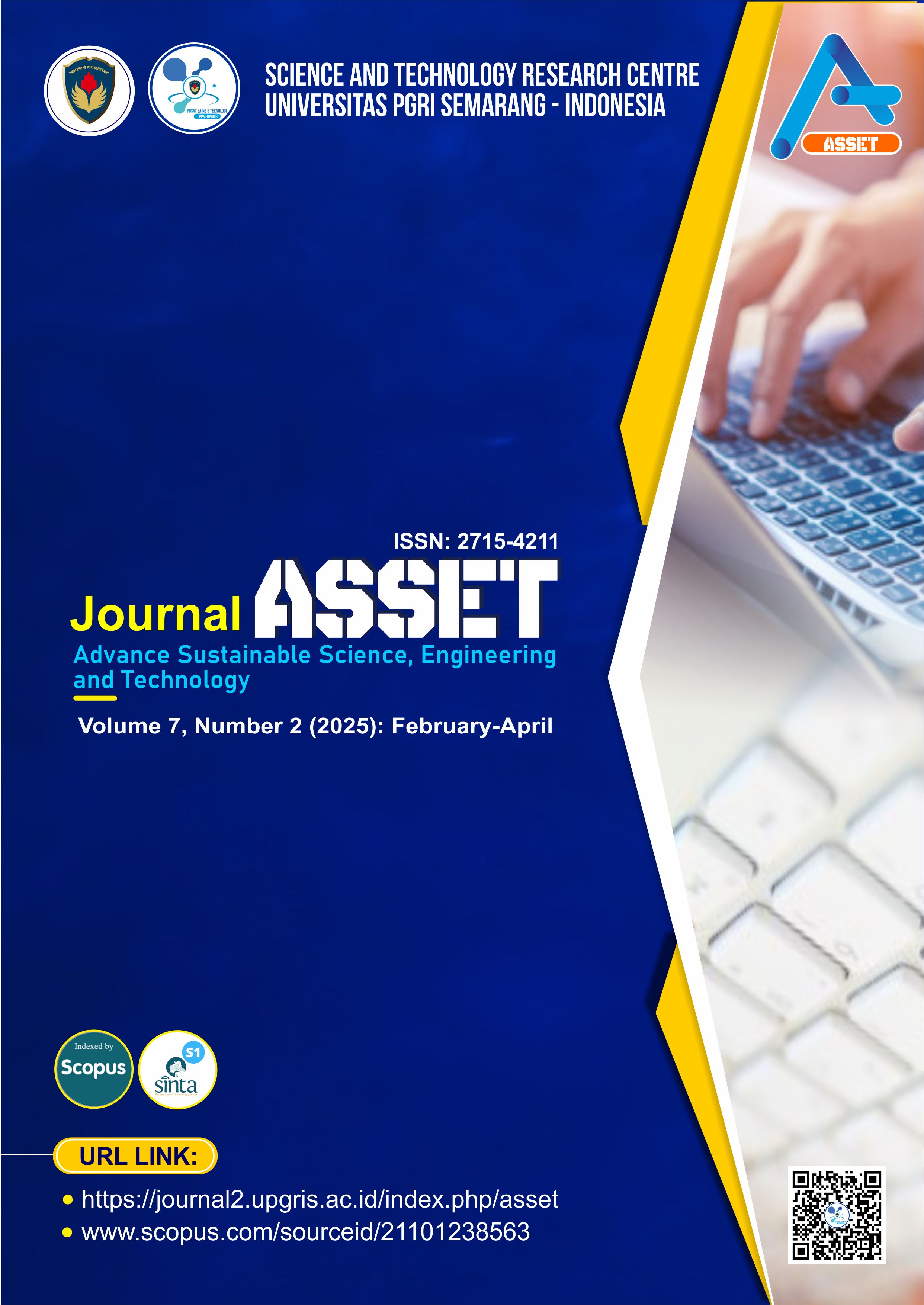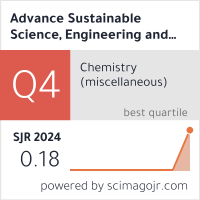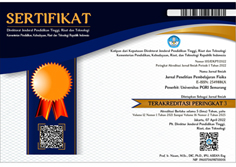A Review of Factors Affecting the Mechanical Performance of PLA in FDM 3D Printing
DOI:
https://doi.org/10.26877/chs1gc62Keywords:
3D Printing, Fused Deposition Modeling (FDM), Mechanical Properties, Polylactic Acid (PLA), Process ParametersAbstract
3D printing has rapidly evolved due to its significant advantages in rapid prototyping. 3D-printed products for industrial applications require stable mechanical properties, which are influenced by various factors. The lack of a comprehensive discussion addressing the factors affecting mechanical properties is the main reason for this review. This article aims to provide an overview of Fused Deposition Modeling (FDM) 3D printing concerning the factors that influence the mechanical performance of FDM 3D products using polylactic acid (PLA) material. The article covers the impact of material factors, process parameters (such as layer thickness, infill patterns, print orientation, infill patterns, infill density, infill width, temperature, and printing speed), as well as post-processing treatments as key considerations. The contribution of this article is to explain to researchers and industry practitioners the factors that affect the mechanical performance of FDM 3D printed products.
References
[1] Rajan K, Samykano M, Kadirgama K, Harun WSW, Rahman MM. Fused deposition modeling: process, materials, parameters, properties, and applications. Int J Adv Manuf Technol 2022;120:1531–70. https://doi.org/10.1007/s00170-022-08860-7.
[2] Lanzotti A, Grasso M, Staiano G, Martorelli M. The impact of process parameters on mechanical properties of parts fabricated in PLA with an open-source 3-D printer. Rapid Prototyp J 2015;21:604–17. https://doi.org/10.1108/RPJ-09-2014-0135.
[3] Cantrell JT, Rohde S, Damiani D, Gurnani R, DiSandro L, Anton J, et al. Experimental characterization of the mechanical properties of 3D-printed ABS and polycarbonate parts. Rapid Prototyp J 2017;23:811–24. https://doi.org/10.1108/RPJ-03-2016-0042.
[4] Amza CG, Zapciu A, Constantin G, Baciu F, Vasile MI. Enhancing mechanical properties of polymer 3D printed parts. Polymers (Basel) 2021;13:1–18. https://doi.org/10.3390/polym13040562.
[5] Pandzic A, Hodzic D, Milovanovic A. Effect of infill type and density on tensile properties of pla material for fdm process. Ann DAAAM Proc Int DAAAM Symp 2019;30:545–54. https://doi.org/10.2507/30th.daaam.proceedings.074.
[6] Joseph TM, Kallingal A, Suresh AM, Mahapatra DK, Hasanin MS, Haponiuk J, et al. 3D printing of polylactic acid: recent advances and opportunities. Int J Adv Manuf Technol 2023;125:1015–35. https://doi.org/10.1007/s00170-022-10795-y.
[7] Elmowafy EM, Tiboni M, Soliman ME. Biocompatibility, biodegradation and biomedical applications of poly(lactic acid)/poly(lactic-co-glycolic acid) micro and nanoparticles. J Pharm Investig 2019;49:347–80. https://doi.org/10.1007/s40005-019-00439-x.
[8] Oleksy M, Dynarowicz K, Aebisher D. Advances in Biodegradable Polymers and Biomaterials for Medical Applications—A Review. Molecules 2023;28. https://doi.org/10.3390/molecules28176213.
[9] Kurowiak J, Klekiel T, Będziński R. Biodegradable Polymers in Biomedical Applications: A Review—Developments, Perspectives and Future Challenges. Int J Mol Sci 2023;24. https://doi.org/10.3390/ijms242316952.
[10] Saefudin S, Cahyandari D, Afif IY, Raharjo S, Subri M, Irawan B. Analisa Parameter Pencetakan Terhadap Sifat Mekanik Polylactic Acid Menggunakan Mesin Cetak 3 Dimensi Fused Deposition Modelling. J Rekayasa Mesin 2023;18:193. https://doi.org/10.32497/jrm.v18i2.4195.
[11] Le L, Rabsatt MA, Eisazadeh H, Torabizadeh M. Reducing print time while minimizing loss in mechanical properties in consumer FDM parts. Int J Light Mater Manuf 2022;5:197–212. https://doi.org/10.1016/j.ijlmm.2022.01.003.
[12] Lokesh N, Praveena BA, Sudheer Reddy J, Vasu VK, Vijaykumar S. Evaluation on effect of printing process parameter through Taguchi approach on mechanical properties of 3D printed PLA specimens using FDM at constant printing temperature. Mater Today Proc 2022;52:1288–93. https://doi.org/10.1016/j.matpr.2021.11.054.
[13] Aslani KE, Chaidas D, Kechagias J, Kyratsis P, Salonitis K. Quality performance evaluation of thinwalled PLA 3D printed parts using the taguchi method and grey relational analysis. J Manuf Mater Process 2020;4. https://doi.org/10.3390/jmmp4020047.
[14] Kafshgar AR, Rostami S, Aliha MRM, Berto F. Optimization of Properties for 3D Printed PLA Material Using Taguchi, ANOVA and Multi-Objective Methodologies. Procedia Struct Integr 2021;34:71–7. https://doi.org/10.1016/j.prostr.2021.12.011.
[15] Hikmat M, Rostam S, Ahmed YM. Investigation of tensile property-based Taguchi method of PLA parts fabricated by FDM 3D printing technology. Results Eng 2021;11. https://doi.org/10.1016/j.rineng.2021.100264.
[16] Soares JB, Finamor J, Silva FP, Roldo L, Cândido LH. Analysis of the influence of polylactic acid (PLA) colour on FDM 3D printing temperature and part finishing. Rapid Prototyp J 2018;24:1305–16. https://doi.org/10.1108/RPJ-09-2017-0177.
[17] Frunzaverde D, Cojocaru V, Ciubotariu CR, Miclosina CO, Ardeljan DD, Ignat EF, et al. The Influence of the Printing Temperature and the Filament Color on the Dimensional Accuracy, Tensile Strength, and Friction Performance of FFF-Printed PLA Specimens. Polymers (Basel) 2022;14. https://doi.org/10.3390/polym14101978.
[18] Frunzaverde D, Cojocaru V, Bacescu N, Ciubotariu CR, Miclosina CO, Turiac RR, et al. The Influence of the Layer Height and the Filament Color on the Dimensional Accuracy and the Tensile Strength of FDM-Printed PLA Specimens. Polymers (Basel) 2023;15. https://doi.org/10.3390/polym15102377.
[19] Hanon MM, Zsidai L, Ma Q. Accuracy investigation of 3D printed PLA with various process parameters and different colors. Mater Today Proc 2021;42:3089–96. https://doi.org/10.1016/j.matpr.2020.12.1246.
[20] Hanon MM, Zsidai L. Comprehending the role of process parameters and filament color on the structure and tribological performance of 3D printed PLA. J Mater Res Technol 2021;15:647–60. https://doi.org/10.1016/j.jmrt.2021.08.061.
[21] Spina R. Performance analysis of colored PLA products with a fused filament fabrication process. Polymers (Basel) 2019;11. https://doi.org/10.3390/polym11121984.
[22] Valerga AP, Batista M, Salguero J, Girot F. Influence of PLA filament conditions on characteristics of FDM parts. Materials (Basel) 2018;11. https://doi.org/10.3390/ma11081322.
[23] Wittbrodt B, Pearce JM. The effects of PLA color on material properties of 3-D printed components. Addit Manuf 2015;8:110–6. https://doi.org/10.1016/j.addma.2015.09.006.
[24] Atakok G, Kam M, Koc HB. Tensile, three-point bending and impact strength of 3D printed parts using PLA and recycled PLA filaments: A statistical investigation. J Mater Res Technol 2022;18:1542–54. https://doi.org/10.1016/j.jmrt.2022.03.013.
[25] Lanzotti A, Martorelli M, Maietta S, Gerbino S, Penta F, Gloria A. A comparison between mechanical properties of specimens 3D printed with virgin and recycled PLA. Procedia CIRP 2019;79:143–6. https://doi.org/10.1016/j.procir.2019.02.030.
[26] Babagowda, Kadadevara Math RS, Goutham R, Srinivas Prasad KR. Study of Effects on Mechanical Properties of PLA Filament which is blended with Recycled PLA Materials. IOP Conf Ser Mater Sci Eng 2018;310. https://doi.org/10.1088/1757-899X/310/1/012103.
[27] Nijdam JJ, Agarwal D, Schon BS. An experimental assessment of filament-extrusion models used in slicer software for 3D food-printing applications. J Food Eng 2022;317. https://doi.org/10.1016/j.jfoodeng.2021.110711.
[28] Che Maideen N, Nazri MH, Budin S, Koay Mei H, Yusoff H, Sahudin S. the Effect of Different Slicing Software on the Manufacturing Performance of 3D Printed Parts. J Mek 2023:72–80. https://doi.org/10.11113/jm.v46.490.
[29] Vettori M, Bergonzi L. A territorial round-robin experiment for the evaluation of mechanical properties of FDM PLA produced by distributed facilities. IOP Conf Ser Mater Sci Eng 2021;1038:012069. https://doi.org/10.1088/1757-899x/1038/1/012069.
[30] Cahyati S, Aziz HR. The Influence of Different Slicer Software on 3d Printing Products Accuracy and Surface Roughness. J Rekayasa Mesin 2021;12:371–80. https://doi.org/10.21776/ub.jrm.2021.012.02.14.
[31] Syamsuzzaman M, Mardi NA, Fadzil M, Farazila Y. Investigation of layer thickness effect on the performance of low-cost and commercial fused deposition modelling printers. Mater Res Innov 2014;18:S6-485-S6-489. https://doi.org/10.1179/1432891714Z.0000000001030.
[32] Afrose MF, Masood SH, Iovenitti P, Nikzad M, Sbarski I. Effects of part build orientations on fatigue behaviour of FDM-processed PLA material. Prog Addit Manuf 2016;1:21–8. https://doi.org/10.1007/s40964-015-0002-3.
[33] Patadiya NH, Dave HK, Rajpurohit SR. Effect of Build Orientation on Mechanical Strength of FDM Printed PLA. Lect Notes Multidiscip Ind Eng 2020;Part F164:301–7. https://doi.org/10.1007/978-981-32-9433-2_26.
[34] Çakan BG. Effects of raster angle on tensile and surface roughness properties of various FDM filaments. J Mech Sci Technol 2021;35:3347–53. https://doi.org/10.1007/s12206-021-0708-8.
[35] Yao T, Ye J, Deng Z, Zhang K, Ma Y, Ouyang H. Tensile failure strength and separation angle of FDM 3D printing PLA material: Experimental and theoretical analyses. Compos Part B Eng 2020;188. https://doi.org/10.1016/j.compositesb.2020.107894.
[36] ERYILDIZ M. Effect of Build Orientation on Mechanical Behaviour and Build Time of FDM 3D-Printed PLA Parts: An Experimental Investigation. Eur Mech Sci 2021;5:116–20. https://doi.org/10.26701/ems.881254.
[37] Khosravani MR, Reinicke T. Effects of raster layup and printing speed on strength of 3D-printed structural components. Procedia Struct Integr 2020;28:720–5. https://doi.org/10.1016/j.prostr.2020.10.083.
[38] Marșavina L, Vălean C, Mărghitaș M, Linul E, Razavi N, Berto F, et al. Effect of the manufacturing parameters on the tensile and fracture properties of FDM 3D-printed PLA specimens. Eng Fract Mech 2022;274. https://doi.org/10.1016/j.engfracmech.2022.108766.
[39] Vǎlean C, Marşavina L, Mǎrghitaşl M, Linul E, Razavi N, Berto F. Effect of manufacturing parameters on tensile properties of FDM printed specimens. Procedia Struct Integr 2020;26:313–20. https://doi.org/10.1016/j.prostr.2020.06.040.
[40] Ma Q, Rejab MRM, Kumar AP, Fu H, Kumar NM, Tang J. Effect of infill pattern, density and material type of 3D printed cubic structure under quasi-static loading. Proc Inst Mech Eng Part C J Mech Eng Sci 2021;235:4254–72. https://doi.org/10.1177/0954406220971667.
[41] Cabreira V, Santana RMC. Effect of infill pattern in fused filament fabrication (FFF) 3D printing on materials performance. Rev Mater 2020;25:1–9. https://doi.org/10.1590/s1517-707620200003.1126.
[42] Agus Tri Wahyudi, Dini Cahyandari, Saefudin S, Muhammad Subri. Impact of infill pattern and line width on tensile strength of PLA FDM 3d printing. TEKNOSAINS J Sains, Teknol Dan Inform 2025;12:98–103. https://doi.org/10.37373/tekno.v12i1.1221.
[43] Sriya Ambati S, Ambatipudi R. Effect of infill density and infill pattern on the mechanical properties of 3D printed PLA parts. Mater Today Proc 2022;64:804–7. https://doi.org/10.1016/j.matpr.2022.05.312.
[44] Aloyaydi B, Sivasankaran S, Mustafa A. Investigation of infill-patterns on mechanical response of 3D printed poly-lactic-acid. Polym Test 2020;87. https://doi.org/10.1016/j.polymertesting.2020.106557.
[45] Dezaki ML, Mohd Ariffin MKA. The effects of combined infill patterns on mechanical properties in fdm process. Polymers (Basel) 2020;12:1–20. https://doi.org/10.3390/polym12122792.
[46] Rismalia M, Hidajat SC, Permana IGR, Hadisujoto B, Muslimin M, Triawan F. Infill pattern and density effects on the tensile properties of 3D printed PLA material. J Phys Conf Ser 2019;1402. https://doi.org/10.1088/1742-6596/1402/4/044041.
[47] Pandzic A, Hodzic D, Milovanovic A. Effect of infill type and density on tensile properties of pla material for fdm process. Ann DAAAM Proc Int DAAAM Symp 2019;30:545–54. https://doi.org/10.2507/30th.daaam.proceedings.074.
[48] Alhazmi MW, Backar AH. Influence of Infill density and Orientation on the Mechanical Response of PLA+ Specimens Produced using FDM 3D Printing. Int J Adv Sci Technol 2020;29:3362–71.
[49] Dobos J, Hanon MM, Oldal I. Effect of infill density and pattern on the specific load capacity of FDM 3D-printed PLA multi-layer sandwich. J Polym Eng 2022;42:118–28. https://doi.org/10.1515/polyeng-2021-0223.
[50] Pandžić A, Hodžić D, Kadrić E. Experimental Investigation on Influence of Infill Density on Tensile Mechanical Properties of Different FDM 3D Printed Materials. TEM J 2021;10:1195–201. https://doi.org/10.18421/TEM103-25.
[51] Seol K-S, Zhao P, Shin B-C, Zhang S-U. Infill Print Parameters for Mechanical Properties of 3D Printed PLA Parts. J Korean Soc Manuf Process Eng 2018;17:9–16. https://doi.org/10.14775/ksmpe.2018.17.4.009.
[52] Böğrekci İ, Demircioğlu P, Saygın Sucuoğlu H, Turhanlar O. the Effect of the Infill Type and Density on Hardness of 3D Printed Parts. Int J 3D Print Technol Digit Ind 2019;3:212–9.
[53] Derise MR, Zulkharnain A. Effect of infill pattern and density on tensile properties of 3d printed polylactic acid parts via fused deposition modeling (FDM). Int J Mech Mechatronics Eng 2020;20:54–63.
[54] Suteja J. Effect of Infill Pattern, Infill Density, and Infill Angle on the Printing Time and Filament Length of 3D Printing. J Rekayasa Mesin 2021;12:145. https://doi.org/10.21776/ub.jrm.2021.012.01.16.
[55] Tanveer MQ, Haleem A, Suhaib M. Effect of variable infill density on mechanical behaviour of 3-D printed PLA specimen: an experimental investigation. SN Appl Sci 2019;1. https://doi.org/10.1007/s42452-019-1744-1.
[56] Maszybrocka J, Dworak M, Nowakowska G, Osak P, Łosiewicz B. The Influence of the Gradient Infill of PLA Samples Produced with the FDM Technique on Their Mechanical Properties. Materials (Basel) 2022;15. https://doi.org/10.3390/ma15041304.
[57] Dave HK, Rajpurohit SR, Patadiya NH, Dave SJ, Sharma KS, Thambad SS, et al. Compressive Strength of PLA based Scaffolds: Effect of layer height, Infill Density and Print Speed. Int J Mod Manuf Technol 2019;11:21–7.
[58] Bergonzi L, Vettori M, Stefanini L, D’Alcamo L. Different infill geometry influence on mechanical properties of FDM produced PLA. IOP Conf Ser Mater Sci Eng 2021;1038:012071. https://doi.org/10.1088/1757-899x/1038/1/012071.
[59] Birosz MT, Andó M, Ledenyák D. Effect of FDM Infill Patterns on Mechanical Properties. SSRN Electron J 2021. https://doi.org/10.2139/ssrn.3950131.
[60] Gunasekaran KN, Aravinth V, Kumaran CBM, Madhankumar K, Kumar SP. Investigation of mechanical properties of PLA printed materials under varying infill density. Mater Today Proc 2021;45:1849–56. https://doi.org/10.1016/j.matpr.2020.09.041.
[61] Lužanin O, Movrin D, Plan M. Effect of Layer Thickness , Deposition Angle , and Infill on Maximum Flexural Force in Fdm-Built Specimens 2014;39.
[62] Liu Y, Bai W, Cheng X, Tian J, Wei D, Sun Y, et al. Effects of printing layer thickness on mechanical properties of 3D-printed custom trays. J Prosthet Dent 2021;126:671.e1-671.e7. https://doi.org/10.1016/j.prosdent.2020.08.025.
[63] Rajpurohit SR, Dave HK. Effect of process parameters on tensile strength of FDM printed PLA part. Rapid Prototyp J 2018;24:1317–24. https://doi.org/10.1108/RPJ-06-2017-0134.
[64] Giri J, Chiwande A, Gupta Y, Mahatme C, Giri P. Effect of process parameters on mechanical properties of 3d printed samples using FDM process. Mater Today Proc 2021;47:5856–61. https://doi.org/10.1016/j.matpr.2021.04.283.
[65] Kuznetsov VE, Solonin AN, Urzhumtsev OD, Schilling R, Tavitov AG. Strength of PLA components fabricated with fused deposition technology using a desktop 3D printer as a function of geometrical parameters of the process. Polymers (Basel) 2018;10. https://doi.org/10.3390/polym10030313.
[66] Abdullah Z, Ting HY, Ali MAM, Fauadi MHFM, Kasim MS, Hambali A, et al. The effect of layer thickness and raster angles on tensile strength and flexural strength for fused deposition modeling (FDM) parts. J Adv Manuf Technol 2018;12:147–58.
[67] Zharylkassyn B, Perveen A, Talamona D. Effect of process parameters and materials on the dimensional accuracy of FDM parts. Mater Today Proc 2021;44:1307–11. https://doi.org/10.1016/j.matpr.2020.11.332.
[68] Nugroho A, Ardiansyah R, Rusita L, Larasati IL. Effect of layer thickness on flexural properties of PLA (PolyLactid Acid) by 3D printing. J Phys Conf Ser 2018;1130. https://doi.org/10.1088/1742-6596/1130/1/012017.
[69] Amirruddin MS, Ismail KI, Yap TC. Effect of layer thickness and raster angle on the tribological behavior of 3D printed materials. Mater Today Proc 2021;48:1821–5. https://doi.org/10.1016/j.matpr.2021.09.139.
[70] Wu J. Study on optimization of 3D printing parameters. IOP Conf Ser Mater Sci Eng 2018;392. https://doi.org/10.1088/1757-899X/392/6/062050.
[71] Khosravani MR, Berto F, Ayatollahi MR, Reinicke T. Characterization of 3D-printed PLA parts with different raster orientations and printing speeds. Sci Rep 2022;12. https://doi.org/10.1038/s41598-022-05005-4.
[72] Yu Z, Gao Y, Jiang J, Gu H, Lv S, Ni H, et al. Study on Effects of FDM 3D Printing Parameters on Mechanical Properties of Polylactic Acid. IOP Conf Ser Mater Sci Eng 2019;688. https://doi.org/10.1088/1757-899X/688/3/033026.
[73] Miazio L. Impact of Print Speed on Strength of Samples Printed in FDM Technology. Agric Eng 2019;23:33–8. https://doi.org/10.1515/agriceng-2019-0014.
[74] Dorado R, Pérez FJ, Medina G, Guerrero F. Experimental measuring of printing speed in FDM. IOP Conf Ser Mater Sci Eng 2021;1193:012037.
[75] Ansari AA, Kamil M. Effect of print speed and extrusion temperature on properties of 3D printed PLA using fused deposition modeling process. Mater Today Proc 2021;45:5462–8. https://doi.org/10.1016/j.matpr.2021.02.137.
[76] Renganathan S, D S. Effect of fill pattern and printing speed on friction characteristics of FDM printed polylactic acid polymer. Adv Mater Process Technol 2022;8:1583–92. https://doi.org/10.1080/2374068X.2021.1948707.
[77] KAMER MS, TEMİZ Ş, YAYKAŞLI H, KAYA A, AKAY O. Effect of Printing Speed on Fdm 3D-Printed Pla Samples Produced Using Different Two Printers. Int J 3D Print Technol Digit Ind 2022;6:438–48. https://doi.org/10.46519/ij3dptdi.1088805.
[78] S. Alsoufi M, W. Alhazmi M, K. Suker D, A. Alghamdi T, A. Sabbagh R, A. Felemban M, et al. Experimental Characterization of the Influence of Nozzle Temperature in FDM 3D Printed Pure PLA and Advanced PLA+. Am J Mech Eng 2019;7:45–60. https://doi.org/10.12691/ajme-7-2-1.
[79] Hsueh MH, Lai CJ, Liu KY, Chung CF, Wang SH, Pan CY, et al. Effects of printing temperature and filling percentage on the mechanical behavior of fused deposition molding technology components for 3d printing. Polymers (Basel) 2021;13. https://doi.org/10.3390/polym13172910.
[80] Behzadnasab M, Yousefi AA, Ebrahimibagha D, Nasiri F. Effects of processing conditions on mechanical properties of PLA printed parts. Rapid Prototyp J 2020;26:381–9. https://doi.org/10.1108/RPJ-02-2019-0048.
[81] Popović M, Pjević M, Milovanović A, Mladenović G, Milošević M. Printing parameter optimization of PLA material concerning geometrical accuracy and tensile properties relative to FDM process productivity. J Mech Sci Technol 2023;37:697–706. https://doi.org/10.1007/s12206-023-0113-6.
[82] Akbaş OE, Hıra O, Hervan SZ, Samankan S, Altınkaynak A. Dimensional accuracy of FDM-printed polymer parts. Rapid Prototyp J 2020;26:288–98. https://doi.org/10.1108/RPJ-04-2019-0115.
[83] Tayyab M, Tanveer MQ, Singari RM, Sathikh PM. Effect of Nozzle Diameter on the Physical Behavior of FDM-Printed Part: An Experimental Study 2024:489–500. https://doi.org/10.1007/978-981-97-4947-8_40.
[84] Schuller T, Jalaal M, Fanzio P, Galindo-Rosales FJ. Optimal shape design of printing nozzles for extrusion-based additive manufacturing. Addit Manuf 2024;84. https://doi.org/10.1016/j.addma.2024.104130.
[85] Ermolai V, Irimia AI. Influence of Nozzle Parameters in 3D Printing Under the Manufacturing Time. Bull Polytech Inst Iași Mach Constr Sect 2021;67:63–72. https://doi.org/10.2478/bipcm-2021-0017.
[86] Triyono J, Sukanto H, Saputra RM, Smaradhana DF. The effect of nozzle hole diameter of 3D printing on porosity and tensile strength parts using polylactic acid material. Open Eng 2020;10:762–8. https://doi.org/10.1515/eng-2020-0083.
[87] Kiński W, Pietkiewicz P. Influence of the Printing Nozzle Diameter on Tensile Strength of Produced 3D Models in FDM Technology. Agric Eng 2020;24:31–8. https://doi.org/10.1515/agriceng-2020-0024.
[88] KARTAL F, KAPTAN A. Investigating the Effect of Nozzle Diameter on Tensile Strength in 3D-Printed Printed Polylactic Acid Parts. Black Sea J Eng Sci 2023;6:276–87. https://doi.org/10.34248/bsengineering.1287141.
[89] Bhosale V, Gaikwad P, Dhere S, Sutar C, Raykar SJ. Analysis of process parameters of 3D printing for surface finish, printing time and tensile strength. Mater Today Proc 2022;59:841–6. https://doi.org/10.1016/j.matpr.2022.01.210.
[90] Szot W, Rudnik M. Effect of the Number of Shells on Selected Mechanical Properties of Parts Manufactured by FDM/FFF Technology. Adv Mater Sci 2024;24:86–103. https://doi.org/10.2478/adms-2024-0006.
[91] Kowalska N, Szczygieł P, Skrzyniarz M, Błasiak S. Effect of shells number and machining on selected properties of 3D-printed PLA samples. Polimery 2024;69:186–90. https://doi.org/10.14314/polimery.2024.3.6.
[92] Suteja TJ. Optimization of Infill Density, Layer Height, and Shell Thickness to Achieve Maximum Bending Strength and Minimum Printing Time of PLA 3D Printed Part. J Polimesin 2023;21:1–5. https://doi.org/10.30811/jpl.v21i5.3883.
[93] Bakar AABA, Zainuddin MZ Bin, Adam AN Bin, Noor ISBM, Tamchek N Bin, Alauddin MS Bin, et al. The study of mechanical properties of poly(lactic) acid PLA-based 3D printed filament under temperature and environmental conditions. Mater Today Proc 2022;67:652–8. https://doi.org/10.1016/j.matpr.2022.06.198.
[94] Chalgham A, Ehrmann A, Wickenkamp I. Mechanical properties of fdm printed pla parts before and after thermal treatment. Polymers (Basel) 2021;13. https://doi.org/10.3390/polym13081239.
[95] Wach RA, Wolszczak P, Adamus-Wlodarczyk A. Enhancement of Mechanical Properties of FDM-PLA Parts via Thermal Annealing. Macromol Mater Eng 2018;303. https://doi.org/10.1002/mame.201800169.
[96] Saefudin S, Cahyandari D, Afif IY, Raharjo S, Subri M, Anwar AN. Peningkatan Sifat Mekanik Produk 3D Printing dengan Proses Annealing. J Ilm Momentum 2023;19:80. https://doi.org/10.36499/jim.v19i1.8568.
[97] Tuazon BJ, Dizon JRC. Additive Manufacturing Technology in the Furniture Industry: Future Outlook for Developing Countries. Adv Sustain Sci Eng Technol 2024;6:02403024. https://doi.org/10.26877/asset.v6i3.908.
[98] Mohammed R, Shaik AS, Mohammed S, Bunga KK, Aggala C, Babu BP, et al. Advancements and Challenges in Additive Manufacturing: Future Directions and Implications for Sustainable Engineering. Adv Sustain Sci Eng Technol 2025;7:0250108. https://doi.org/10.26877/asset.v7i1.1079.











